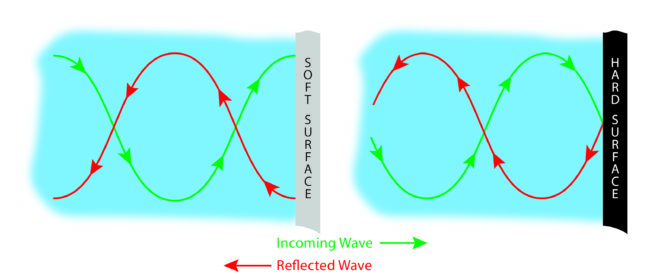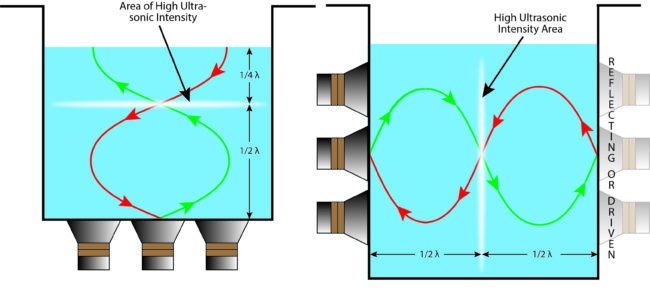The term “near field” is not new to ultrasonic cleaning. In general, it refers to cleaning parts in near proximity to the ultrasound source. It is well known that increasing ultrasonic power density can produce improved cleaning results in many cases. Increasing power density can be accomplished by reducing the size of the cleaning vessel to contain the ultrasonic waves or by simply positioning the work near the ultrasonic source. Reducing the size of the cleaning vessel is probably the better choice, especially with multi-sided parts, as simply moving them closer to the source without reducing the vessel size is liable to produce a one-sided effect with the side toward the transducer benefiting from the placement while the one facing away does not. This concept is discussed in some detail in an earlier blog which was written in response to a reader question and provides some general guidelines.
Although the above describes the general concept of near-field, there are ways to even further intensify ultrasonic energy using reflective surfaces to focus ultrasonic fields to produce areas of constructive interference. This is accomplished by either reflecting waves from a single source to join to produce an intensified field or by adding an additional ultrasonic source or sources positioned in such a way that wave fronts coincide to produce an enhanced effect. The basic physics for the following discussion is shown in the blog Sound Physics – Nodes and Antinodes – Part I.
Reflected Coincidence –
In order to produce this effect, there needs to be a sound reflecting surface opposite the ultrasonic source. The most common reflectors are the side wall of the vessel or the liquid surface. The proper spacing to produce a coincident wave depends on the nature of the reflector. As shown in the blog Sound Physics – Nodes and Antinodes – Part II a soft or compliant surface (liquid-air interface, rubber and other soft surfaces) reflects a wave reversed in phase from the incoming wave while a hard or non-compliant surface (the wall of the vessel, glass and other hard surfaces) reflects a wave in phase with the incoming wave. The following illustrations show the intensity of the pressure wave as it reflects from soft and hard surfaces.

In the above, the maximum pressure or “pressure node” will occur where the incoming and reflected wave intersect. In the case of the reflection from the soft surface, the first intersection occurs 1/4 wavelength from the reflecting surface with additional intersections every 1/2 wavelength thereafter. In the case of the reflection from the hard surface, the first intersection occurs 1/2 wavelength from the reflecting surface with additional intersections every 1/2 wavelength thereafter. Each intersection provides a high intensity ultrasonic zone.

The illustrations show application in ultrasonic tanks. On the left, the air/liquid interface at the top acts as a “soft” reflector returning the wave out of phase with a high intensity zone created 1/4 wavelength below the surface of the liquid. On the right, the side wall of the tank opposing the transducers acts as a “hard” reflector returning the wave in phase creating a high intensity zone 1/2 wavelength from the reflecting surface. As an option, it is possible to add a second synchronized transducer array on the reflecting surface (as shown in the phantom view) to further intensify the effect. The wavelength (λ) of sound in water is roughly 3″ at 20kHz and 1.5″ at 40kHz. Since these numbers vary based on temperature, chemical additions and several other factors, equipment should be adjustable to achieve optimum results.
Note – All of the above is based on a tank without any parts in place to be cleaned. The introduction of parts disturbs the sound waves and, depending on the size and orientation of the parts, may partially or completely negate the effect. The technology has been shown effective on wire, strip, sheets and small parts that can be precisely positioned in the active zone.




 English
English Spanish
Spanish Chinese
Chinese Canada
Canada Mexico
Mexico United Kingdom
United Kingdom



